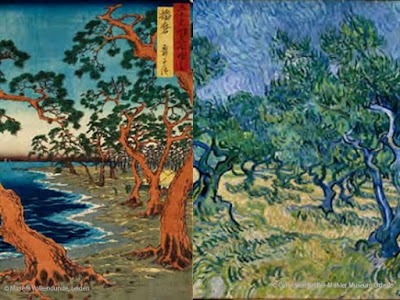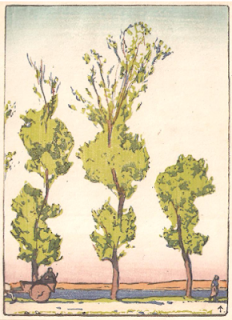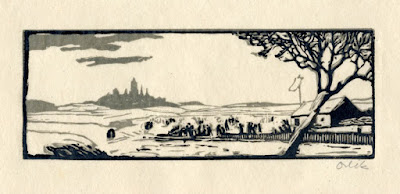Several years ago (2011 !) Charles wrote his posting and spoke in admiration of Siegfried Berndt (read here). Berndt's influence on Modern Printmaking is probably much greater then until now is realized. In 2013 a booklet, referred to in the comments of Charles posting, was published.
Here're the two earliest examples I could find (also 1906 !) showing the steps of Pillnitz Castle near his native Dresden on river Elbe, and Windstille" a truly remarkable early print. It shows he already was heavily inspired, influenced and experienced with printmaking "the Japanese way". In those years (from 1905) Emil Orlik just had started teaching in Berlin. I often wonder about the possible connections. It is even said Berndt taught and trained his teachers and professors in Dresden in woodblock printmaking (!) And because of that his printmaking influence must be in every Dresden later trained printmaker including the later expressionist "Brücke" artists, Martin Erich Philipp and many others.
This is a fine opportunity showing you some remarkable things that I've discovered recently comparing pictures of prints by Berndt from my pictures archive (I actually own just one print by Berndt, the iconic sailing boat print (later) as my interest and true field of investigation and collecting is pioneering German women printmakers born before 1900 (they were all followers, not teachers, but it is the influence of their possible teachers that is so interesting).
I noticed Berndt played with composition comparing this color print of Notre Dame and a similar, also 1912, monochrome print obviously inspired by his Paris visit. (Meeting Henri Riviere , August Lepere and the Beltrand brothers ?) The question is wether he elongated or shortened the composition: I suggest the first.
(Note he actually separated the lower part from the upper, moving Notre Dame to the right by adding a bridge arch to the left but stretching the ships to the right !) probably to position the hauling sailor underneath the large vertical spire dividing the composition more harmoniously.
(Note he actually separated the lower part from the upper, moving Notre Dame to the right by adding a bridge arch to the left but stretching the ships to the right !) probably to position the hauling sailor underneath the large vertical spire dividing the composition more harmoniously.
 He did the same with the sailing boat print, changing the composition from square to vertical. In this case by adding an inch or so to the bottom with an extra block.
He did the same with the sailing boat print, changing the composition from square to vertical. In this case by adding an inch or so to the bottom with an extra block.
And then it struck me I could hardly find two identical prints of the same print/composition (there are, probably when he was content printing an edition) showing he experimented happily with his blocks.
And then, by sheer co-incidence, I stumbled over this Japanese woodblock by (I think by Hasagawe Satanobu II 1848-1940 or his father HS I (1809-1875). Could this be the print for Berndt's inspiration ?
Some serious research has been done into the Japanese prints that inspired Vincent van Gogh (1853-1890) and comparing is besides great fun revealing much about the artists history and history of Art.
In Scotland-Edinburgh I suspect Berndt will have met Frank Morley Fletcher (1866-1949) who was head of the Edinburg college of art from 1907 and before he had been experimenting, like Berndt, making prints in the Japanese way in London. Around the time Orlik came back from his Japan experience in 1901 and moving from Munich to Berlin.
Experimenting Berndt did with almost all his prints. These are just examples that I managed to find and safe, there must be many others available. Here's a 1911 print showing a Polish village and landscape in different colors which made me think of Fletchers print made in 1916.
Please consider these are just personal observations and in no way to be valued having any art historical relevance. And beware: there's even more to come ...........
All pictures borrowed freely from the Internet for friendly, educational and non commercial use only.





















